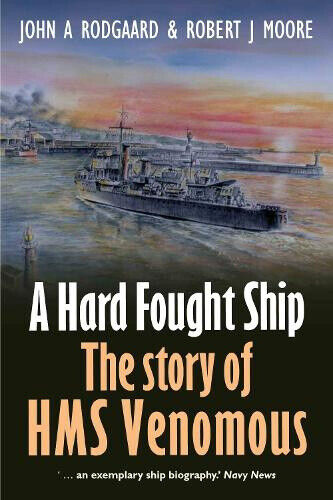
A Hard Fought Ship – The Story of HMS Venomous. By John A. Rodgaard and Robert J Moore. Seaforth Publishing, Barnsley, United Kingdom 2024.
Reviewed by John Mortimer
This book is a second edition, the original being published in 1990 and authored by Robert Moore. The second edition has been updated and expanded by the current authors.
Chapter One Pedigree 1893-1919 outlines the brief history of destroyer development and their predecessors. It provides an overview of the V and W class development and notes that Venomous was one of the last series of ships to be built in the class. The modified W class is compared with their foreign contemporaries – the USN Wickes, French Arabe, Italian Palestro, and Japan’s Minekaze. The analysis concludes that: “Not only was Venomous heavily armed, but the main battery of guns and torpedoes were well positioned on her long upper deck, allowing most of these weapons to be engaged from any firing quarter…. Venomous had well thought out design characteristics which would become standard on future classes of destroyers….and was a capable and powerful ship for the period.”
The remaining chapters detail the eventful life of Venomous and draw heavily on official records such as the Ship’s Logs, Reports of Proceedings, reports of attacks and action damage, reports on the evacuation from Dunkirk, Report on the collision between HMS Keppeland HMS Venomous, and reports on convoy escort operations. This data is complemented by diaries compiled by crew members and interviews of crew to provide a very accurate picture of the work undertaken by Venomous and what living and operational conditions the ship and its crew experienced in both peace and war. This latter aspect is fundamental to an understanding of the rigors, stresses and satisfaction experienced by personnel who chose to serve their nation at sea.
This body of research is complemented by the author’s consultation of a range of books and other sources to provide a broad discussion on international relations, government policy, strategy, political and financial matters, and the evolution of technology with its impact on naval ship design, capability and operations.
“A Hard Fought Ship” is particularly strong in its coverage of shipboard life during both peace and war. Conditions in the Baltic in 1919 were extremely harsh. In many respects, it is complementary to The Cruel Sea in providing an intimate look at life aboard a small warship in peace and war. Midshipman Gotto recorded in his diary the following remarks on conditions in the Baltic:
“It is freezing hard and there is quite a lot of ice about. Kept forenoon watch on the bridge…. Went through a lot of pack ice …. During the night we were patrolling up and down through the ice all the time.”
“Proceeded out of harbour for Chatham. There was a very strong gale blowing…. then the seas were so bad we had to proceed at reduced speed. No one was allowed on the upper deck and for two days all watch keeping Officers slept and lived in the Chart House. We arrived at last on Sunday 28 December at Chatham after an extremely uncomfortable passage, our cabin being flooded with water about 1 1/2 to 2 feet deep.”
Following these passages is a photo showing the Venomous bridge and foredeck heavily encrusted with ice.
This is a first-class biography of HMS Venomous and its crew. It serves as a benchmark for future books which seek to emulate its coverage. The book is well written, and the text is complemented with photographs which show both the ship and its crew at various stages of its life.
The V and W class destroyers were highly capable when built and were no doubt one of the best designs for their times. While they provided the benchmark for subsequent British destroyer designs, by the time of the Second World War they had been driven very hard and required major modernisation to suit them for operations in the Battle of the Atlantic and elsewhere. Their range was enhanced to provide better endurance and their weapons and sensors were also improved to meet the air and submarine threat more effectively. The Royal Australian Navy operated four ships of this class during the Second World War – Vampire,Vendetta, Voyager and Waterhen.



